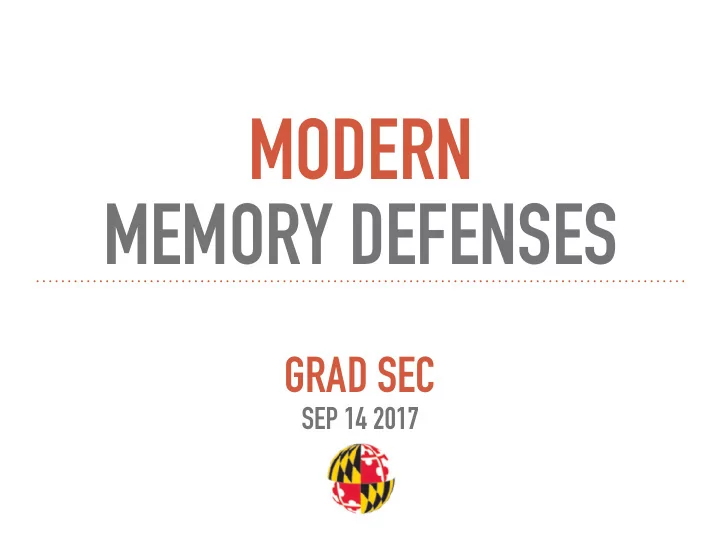

MODERN MEMORY DEFENSES GRAD SEC SEP 14 2017
TODAY’S PAPERS
CONTROL FLOW INTEGRITY Fundamentally, code injection attacks altered the target program’s control flow Recall: Confidentiality, Integrity, Availability Most integrity defenses seek to detect Typically they are unable to outright prevent
CONTROL FLOW GRAPH Code injection, return to libc, ROP … all of them alter where one of the “ret”s points
REFERENCE MONITORS Code or system responsible for checking whether data/execution matches some policy File permissions, password checker, airline employees checking tickets… Mediates between user and sensitive resource CFI is an inline reference monitor
ENSURE COMPLETE MEDIATION
SOFTWARE FAULT ISOLATION (SFI) Insert code at each machine code instruction to ensure that the target memory region lies within some bounds Keep only the LSBs (zero with ‘and’ then add the target memory region’s MSBs
INTEGRITY WITH LABELS Note that we start in the trusted code. The goal is to make sure we never ret somewhere we shouldn't
INLINING CFI Will only jump to a part of the code with the label 0x12345678
SECURITY GUARANTEES Attack model: arbitrary control over the data portion of memory UNQ: No label appears elsewhere in code NWC: Code segment is not writable NXD: Data segment is not executable
SOFTWARE FAULT ISOLATION (SFI) Insert code at each machine code instruction to ensure that the target memory region lies within some bounds Normally you want the ‘and’ in the loop, But CFI ensures no jumps into the loop
LABELS ARE NOT UNIQUE Attacker could potentially cause sort() to return to either of the memory locations labelled 55
LABELS ARE NOT UNIQUE Code duplication Shadow stack
SHADOW CALL STACKS One possibility: SFI to maintain a region of memory (e.g., 0x1*) specifically for the shadow call stack Hardware support: x86 offers memory segments %gs always points to shadow stack segment Protected by CFI + static analysis of code
SECURITY GUARANTEES Attack model: arbitrary control over the data portion of memory UNQ: No label appears elsewhere in code NWC: Code segment is not writable NXD: Data segment is not executable
EVALUATION Shadow stack reduces some unnecessary ID checks during returns
CFI: SHORTCOMINGS
CFI: SHORTCOMINGS No dynamically generated code (functional programming?) Requires recompiling the code
TODAY’S PAPERS
TAINT TRACKING: HIGH LEVEL IDEA Potentially malicious input “taints” memory Track what gets tainted Enforce that some operations only work on untainted data
TAINT TRACKING: CHALLENGES How do we track memory accesses? How do we keep track of what's tainted? How do we protect the taint info? How do we “propagate” taint?
TAINT PROPAGATION (TAINTDROID) Define what propagation rules for all operations
TAINT TRACKING Instrument every (relevant) operation Mechanism: Valgrind Translates x86 into its own instruction set Passes these to TaintCheck TaintCheck passes back modified instructions Add code to update taint info
TAINT STORING: RETURN OF THE SHADOW 1 byte memory -> 4 byte pointer -> taint data structure
POLICY CHECKING Must specify what operations aren't permitted on tainted data
EVALUATION Has the possibility for false positives, false negatives
EVALUATION Has the possibility to adversely affect performance
EVALUATION Has the possibility to be overtrained to known vulnerabilities
TAINTDROID
TAINTDROID
Recommend
More recommend